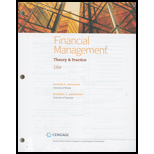
Concept explainers
a.
Determine: Expected return and standard deviation of the portfolio invested.
a.
Explanation of Solution
Given information:
It is given that expected return of A is 0.07, expected return of B is 0.10, expected return of C is 0.20, standard deviation of A is 0.3311, standard deviation of B is 0.5385, standard deviation of C is 0.8944, correlation coefficient between A and B is 0.35, portfolio invested in A is 30% and in B is 70%.
Formula to calculate expected return is as follows:
Substituting Equation with 0.10 for the return of A and 30% for the portfolio invested in A, 0.16 for the return of B and 70% for the portfolio invested in B to calculate expected return.
Hence, the expected return from portfolio investment of 30% in stock A and 70% in stock B is 14.2%.
Formula to calculate standard deviation of the portfolio invested is as follows:
Substituting Equation with 0.30 for Wa, 0.20 for σa, 0.70 for Wb, 0.40 for σb to calculate standard deviation of the portfolio invested.
Hence, standard deviation of the portfolio invested is 88.98%.
b.
Determine: Expected return and standard deviation of the portfolio invested.
b.
Explanation of Solution
Given information:
It is given that expected return of A is 0.10, expected return of B is 0.16, standard deviation of A is 0.20, standard deviation of B is 0.40, correlation coefficient between A and B is 0.35, portfolio invested in A is 30% and in B is 70%.
Formula to calculate expected return is as follows:
Substituting Equation with 0.10 for the return of A and 30% for the portfolio invested in A, 0.16 for the return of B and 70% for the portfolio invested in B to calculate expected return.
Hence, the expected return from portfolio investment of 30% in stock A and 70% in stock B is 14.2%.
Formula to calculate standard deviation of the portfolio invested is as follows:
Substituting Equation with 0.30 for Wa, 0.20 for σa, 0.70 for Wb, 0.40 for σb to calculate standard deviation of the portfolio invested.
Hence, standard deviation of the portfolio invested is 88.98%.
c.
Determine: Expected return and standard deviation of the portfolio invested.
c.
Explanation of Solution
Given information:
It is given that expected return of A is 0.10, expected return of B is 0.16, standard deviation of A is 0.20, standard deviation of B is 0.40, correlation coefficient between A and B is 0.35, portfolio invested in A is 30% and in B is 70%.
Formula to calculate expected return is as follows:
Substituting Equation with 0.10 for the return of A and 30% for the portfolio invested in A, 0.16 for the return of B and 70% for the portfolio invested in B to calculate expected return.
Hence, the expected return from portfolio investment of 30% in stock A and 70% in stock B is 14.2%.
Formula to calculate standard deviation of the portfolio invested is as follows:
Substituting Equation with 0.30 for Wa, 0.20 for σa, 0.70 for Wb, 0.40 for σb to calculate standard deviation of the portfolio invested.
Hence, standard deviation of the portfolio invested is 88.98%.
Want to see more full solutions like this?
Chapter 25 Solutions
FINANCIAL MANAGEMENT(LL)-TEXT
 Essentials of Business Analytics (MindTap Course ...StatisticsISBN:9781305627734Author:Jeffrey D. Camm, James J. Cochran, Michael J. Fry, Jeffrey W. Ohlmann, David R. AndersonPublisher:Cengage Learning
Essentials of Business Analytics (MindTap Course ...StatisticsISBN:9781305627734Author:Jeffrey D. Camm, James J. Cochran, Michael J. Fry, Jeffrey W. Ohlmann, David R. AndersonPublisher:Cengage Learning

